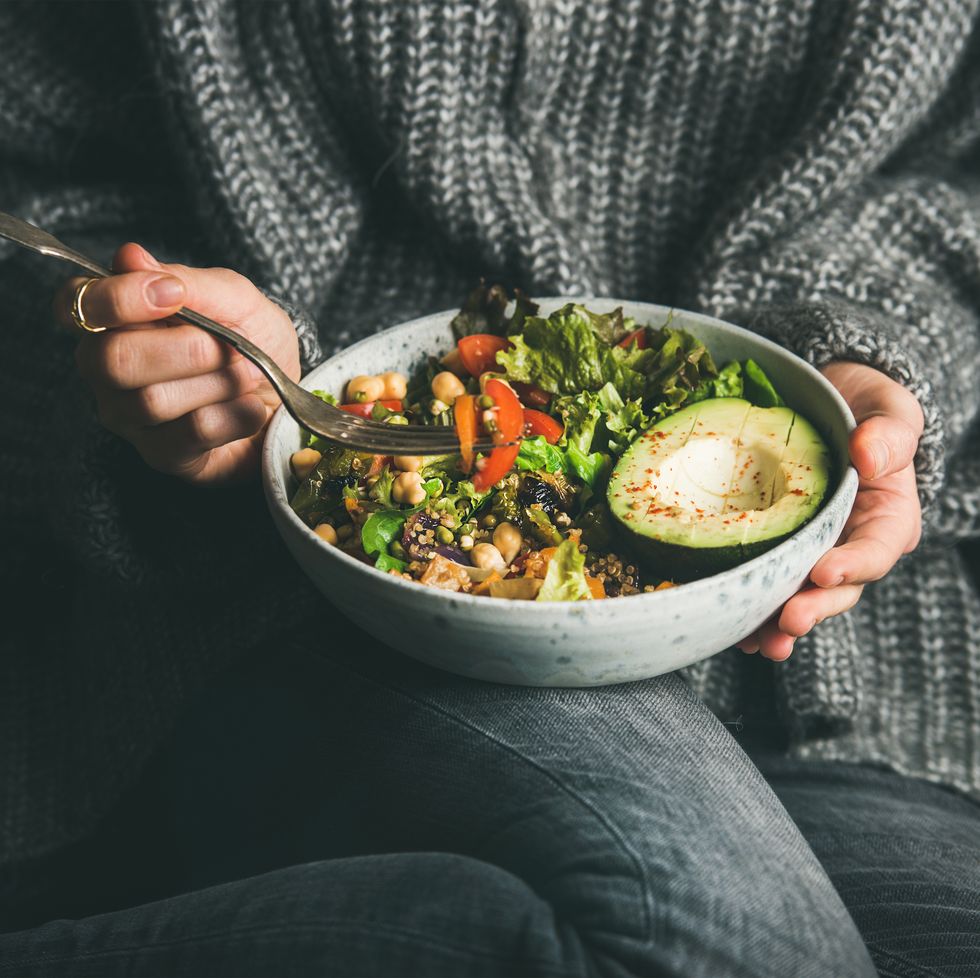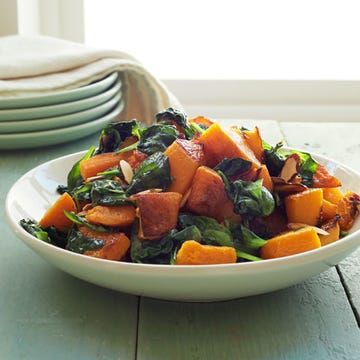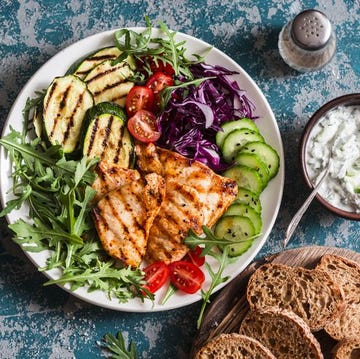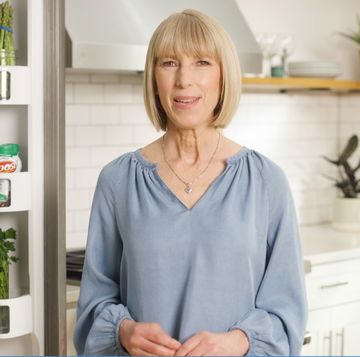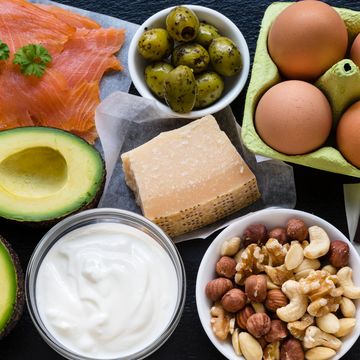In a country that's obsessed with the size and shape of people's bodies — especially women's bodies — fad diets that are less about healthy eating and more about promoting unrealistic body and beauty standards have long-been all the rage. Whether it's counting calories, fasting, or yo-yo dieting, every week (or so it seems) there's a new diet promising health, wellness, and let's face it: weight loss. Which is why it's understandable (in fact, beneficial!) to question the newly-popular diet, known as the flexitarian eating plan. But unlike other diets, the key to this type of semi-vegetarian eating regiment is in the name: flexibility.
“The flexitarian diet gives you the freedom to eat your favorite foods, participate in social events, and travel without feeling like you’re sacrificing healthy eating," Dawn Jackson Blatner, RDN and author of The Flexitarian Diet, tells Woman's Day. "Flexibility is consistency, and on the flexitarian plan you’ll be able to make the diet work with your lifestyle."
This less restrictive alternative to more conventional diets focuses on eating more plant-based foods, while not entirely giving up meat. This flexibility allows for guilt-free indulgences (that don't promote the idea of "good" or "bad" foods) while encouraging eating more vegetables and nutrient-dense foods.
More From Woman's Day

Here's everything you need to know about the flexitarian eating plan, and how you can make it work for you (if you want!).
What is the flexitarian diet?
Flexitarian is a combination of the words "flexibile" and vegetarian." In other words, this eating regiment focuses on increasing the amount of plant-based foods in your diet, while decreasing the amount of meat, processed foods, and added sugars (but not cutting them out entirely).
“I think of it as a pro-plant style of eating, not anti-meat,” Blatner explains. “As opposed to an omnivore, which is someone who eats everything, a flexitarian has the intention of eating a diet grounded in more plant-based foods.” Blatner says that there are three different flexitarian levels, all based on the amount of meatless meals a person eats per week (out of a total of 21 weekly meals). Beginners eat six to eight meals per week, or approximately 26 ounces of meat in total. More advanced flexitarians eat between nine and 16 meat-free meals, or only 18 ounces of meat. And finally, expert flexitarians will eat 15 or more meatless meals in a week, or around nine ounces of meat total.
What foods can flexitarians eat?
"All food groups are included on the diet," Blatner says, "except there’s less emphasis on animal protein, and more emphasis on plant-proteins.” So while you're free to eat whatever you desire (yay, flexibility!), Blatner recommends centering your meals around plant-proteins, like black beans, pinto beans, garbanzo beans, white beans, and lentils, coupled with whole grains and potatoes, vegetables, fruits, dairy, eggs, and healthy fats, like olive oil, avocados, and fish.
What foods do flexitarians avoid?
Again, the name of the game is flexibility, so you have the option of designing your meals however you see fit. Having said that, there are certain foods that Blatner recommends flexitarians work to avoid whenever possible. Those foods include, but are not limited to: chicken, turkey, red meat, pork, white pasta, white bread, white rice, animal fats, and overly processed and/or packaged foods.
What are the benefits of being flexitarian?
“Eating more plant-based foods increases the amount of fiber and antioxidants consumed, which can lower the risk of heart disease and HbA1c numbers (a blood test that shows your blood sugar level and is used to monitor diabetes), decrease weight, and better manage type 2 diabetes,” Fran Grossman, RDN and nutrition consultant, tells Woman's Day. “The vegetables, fruits, seeds, and legumes of the flexitarian diet are all helpful in disease prevention.” And a 2016 study published in Frontiers in Nutrition found that the flexitarian diet can improve overall health, lower blood pressure, help with cancer prevention, and increase HDL (your good cholesterol).
Who is this diet good for?
“It is suitable for almost anyone,” Grossman says, "as long as you’re following it correctly. Taking out meat is not enough. You also need to increase plant-based foods, and focus on taking out added sugars and refined carbohydrates.” Grossman notes that many of her clients are receptive to following a flexitarian plan, primarily because it is not overly restrictive. “They don’t have to give up that steak dinner for a special occasion," she explains. "It works because you don’t end up feeling resentful from trying to follow an overly rigid regimen.”
What are the risks of being flexitarian?
“The disadvantages of being a flexitarian are when people may not meet their nutrient requirements from overly restricting meat and not replacing those nutrients with plant-based equivalents,” Grossman says. “You still need iron, zinc, and B12, and if you’re restricting meat without balancing out these missing nutrients, you could run into trouble.” Grossman recommends increasing foods high in iron when removing meat (beans, lentils, seeds, nuts, fortified cereals), along with foods high in vitamin C, which help the body better absorb iron. In addition, if you’re decreasing your dairy intake, you should try plant-based milk alternatives — like coconut, oat, or hemp milk — and increase foods high in calcium by incorpirating things like bok choy, kale, and sesame seeds into your diet.
How to start today.
There are three main steps to becoming a flexitarian today, Blatner says. First, you should downsize your meats. “You don’t even have to cut meat out,” she explains. “But instead of a nine ounce steak, eat a three or four ounce one. The first step is reapportioning the amount of meat you consume, and adding more veggies and whole grains.” The second step is to incorporate vegetables into your favorite meat-based meals. “Swap some or all of the meat in your favorite recipes for plant-based proteins," Blatner says. "For example, you can still have Taco Tuesday, but instead of ground beef or chicken, try seasoned lentils.” Finally, try making at least one new vegetarian recipe a week.“Trying just one new plant-based recipe each week keeps food interesting, but also isn’t overwhelming," Blatner explains. "Not getting bored with your meals makes it more fun and easier to be a flexitarian for life.”
If you’re looking to eat more plant foods without giving up meat altogether, the flexitarian diet might be a good fit for you. Remember to start slowly, make sure you’re cutting back on sugar and simple carbs (if you want!), and add in any nutrients you might be lacking as you eat less and less meat.
Give the gift of more recipes! Send your loved one 12 issues of Woman’s Day for $7.99! And while you’re at it, sign up for our FREE newsletter for even more of the Woman's Day content you want.


